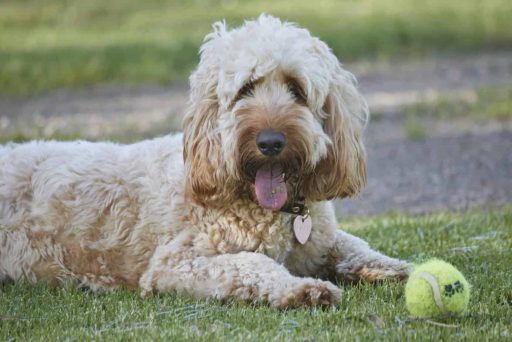What Is A Whoodle?
The Whoodle is a designer breed with one parent that is a Soft-Coated Wheaten Terrier while the other parent is a Poodle. The Poodle may be a standard Poodle, miniature Poodle, or a toy Poodle. Having a standard or miniature Poodle parent is the most common.
To understand the Whoodle a bit better let’s look at the two parent breeds, the Soft-Coated Wheaten Terrier and the Poodle.
Soft-Coated Wheaten Terriers originated in Ireland. They were bred primarily to be a farm dog but were used for guarding, herding, ratting, and as gun dogs. They are a very versatile breed and are generally happy and very devoted dogs.
The Poodle originated in Germany. They were originally bred to be gun dogs and were used as retrievers by hunters. They are an active and intelligent breed that require a lot of attention and exercise. Today, poodles come in three sizes: standard, miniature, and toy.
So, as you can expect the Whoodle is going to be a mixture of its two parent breeds. Some Whoodles will take after the Poodle side and some will take after the Soft-Coated Wheaten Terrier side. In general, you can expect the Whoodle to be a friendly, energetic, breed that is very trainable and makes a great family pet.
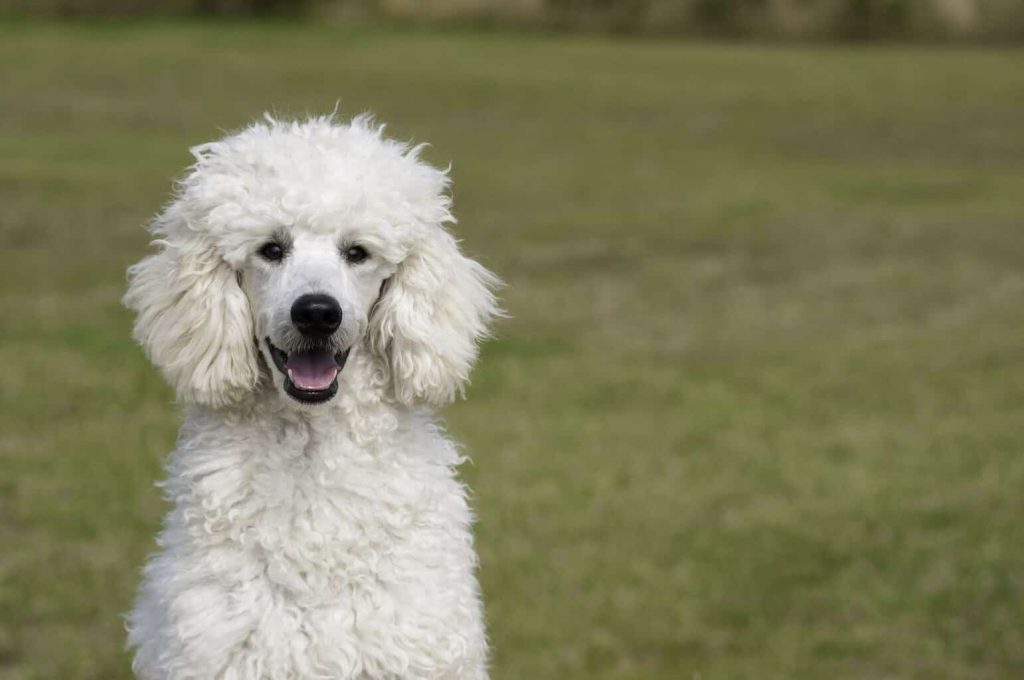
The Whoodle’s physical characteristics can vary quite a bit. The main differences will be dependent upon what size the Poodle parent is. If the Poodle is bigger the Whoodle will likely be bigger, if the Poodle parent is smaller the Whoodle will be smaller.
The Whoodle can grow to between 10 to 20 inches tall and may weigh anywhere from 20 to 70 pounds, making it a medium sized dog breed.
What Kind of coat does a whoodle have?
The Whoodle has a dense, single coat that is wavy or curly and is very soft to the touch. It doesn’t shed as much as a double-coated breed, but it does need to be trimmed frequently. So whilst it is generally more hypoallergenic than other crossbreeds, it does require grooming every 6 to 8 weeks.
The dog’s coat can come in many colors, and it may be a combination of the parent’s coat colors or be totally different. Common Whoodle coat colors include black, apricot, beige, red, chocolate, silver, spotted, and all of these can come with or without white patching.
What Temperament Do Whoodles Have?
The Whoodle is a friendly, sociable dog that loves being around people. They are also intelligent and easy to train, especially if the training starts when they are fun.
As a family pet, they are playful, affectionate, and often boisterous. They are known to bark at strangers or house visitors, but they are not usually aggressive and any undesirable behavior is usually caused by fear or lack of training.
Are Whoodles Good Family Dogs?
Yes, Whoodles make great family dogs.
Depending on the size of the Whoodle they can do well in an apartment if they get enough exercise. However, any Whoodle will also enjoy a large fenced yard to romp in. The Whoodle is a fairly high-energy breed so they need plenty of exercise to be happy.
In general, the breed gets along well with children. They make for very playful friends for children. They will do well with young kids if they are well socialized with them from a young age – making them a great family member!
The Whoodle will usually get along well with other dogs too. The breed will also enjoy trips to the dog park to make new friends. They also typically fit well into a household that already has dogs. The Whoodle may do well with other pets if he is socialized with them from a young age. The breed has a high prey drive and may try to chase smaller pets as a game.
Whoodles are not usually barkers, as long as they get the mental and physical stimulation they need. Just like any breed, if they become bored they can get barky. Depending on their genetic line, some Whoodles will have more guarding instincts and may tend to bark a little more than others.
The Whoodle is devoted to his family and can develop separation anxiety if left alone for long periods of time. Keep this in mind as you assess your lifestyle to see if you have the time to dedicate to a Whoodle.
Are Whoodles Hard To Train?
Whoodles can be difficult to train and can take after either of their parents when it comes to their trainability.
Poodles are very smart dogs and have a strong desire to please their owner. This goes back to their days of working as retrievers for their owners. Poodles were bred to work closely with their humans.

On the other side, we have Soft-Coated Wheaten Terriers. These dogs are intelligent but can be a bit stubborn. They were bred to be farm dogs, doing all sorts of tasks. In some of the tasks, they would work closely with people, such as when they would do herding or retrieving.
But for many other tasks, they worked alone such as ratting and guarding, and did not need human direction.
So, the Soft-Coated Wheaten Terrier is not always super motivated to work with people, and this trait is often passed on to the Whoodle.
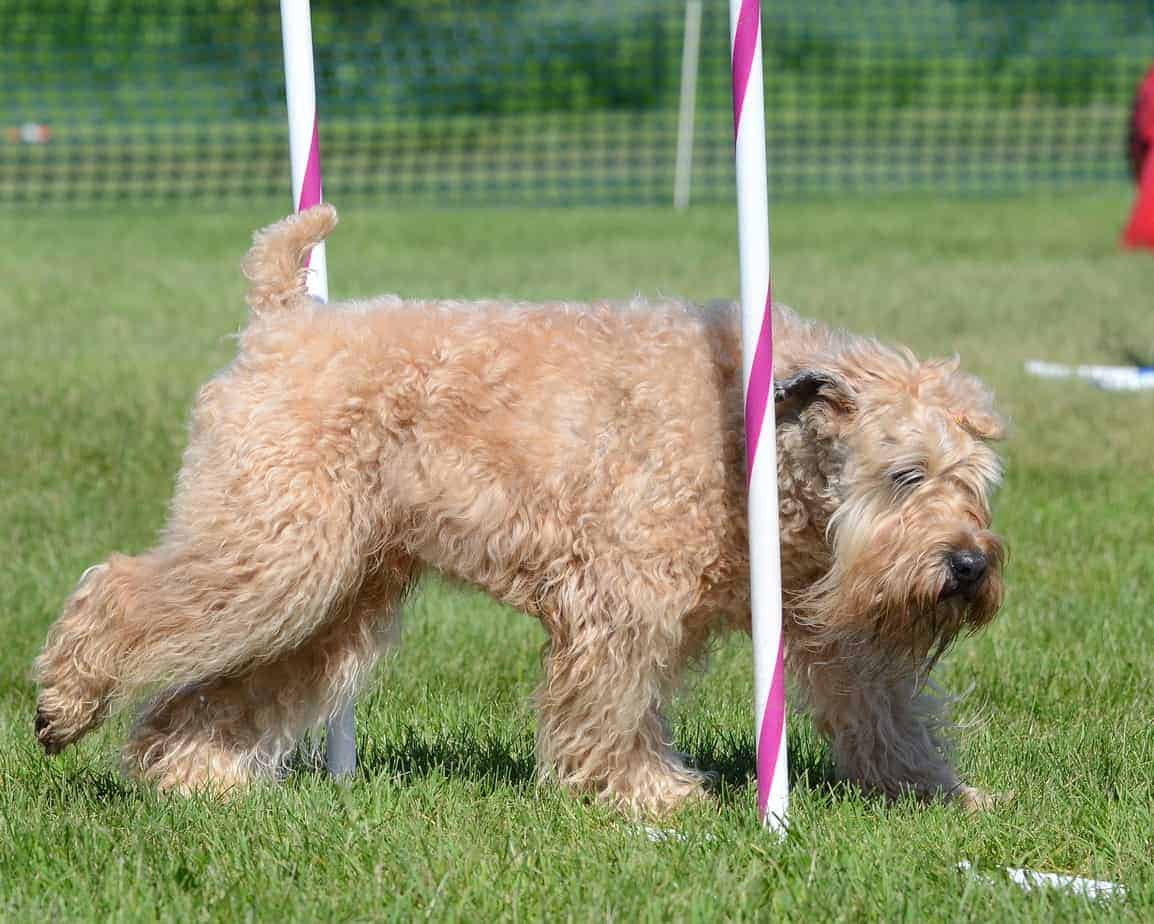
Since the Whoodle is a mixture of these two breeds, he may be more like the Poodle or be more like the Soft-Coated Wheaten Terrier. This could mean that he will be easy to train or a bit more of a challenge. Either way, positive reinforcement training is the best approach to take.
Positive reinforcement training focuses on letting your dog know when he is being good and doing what you want him to do. This is much better for everyone involved. If you only punish your dog for doing what you do not want him to do, then he never really knows what you do want him to do.
Rewards can be anything from praise or treats, to toys and games. Treats work well for most dogs. Be sure to have a variety of treats, the same old treat makes training boring.
Because the Whoodle has such a high prey drive using toys as a reward is a great option for the Whoodle. When he does something right, whip out a toy and have a quick game. Alternating between treats and toys is a great way to keep training exciting.
As with any dog, socialization is key to a happy and well-adjusted adult dog. The Whoodles socialization should begin at the breeder’s home and then continue through the life of the dog. This means that you need to keep exposing your dog to new experiences, people, dogs, and other animals. Always make socialization a positive experience.
The Whoodle is a fairly high-energy breed. Both parent breeds were bred to be busy doing their job all day long.
That said, the exercise requirements of the Whoodle will vary depending upon the size of the Poodle parent. If the Whoodle has short legs due to a toy Poodle parent he will require less exercise than a longer-legged Whoodle with a standard-sized Poodle parent.
In my experience, an hour of exercise a day is what your Whoodle will likely need. However, the more exercise you can give the Whoodle the better. If the breed has too much excess energy they will find other things to do like bark, dig in the yard, and chew things up that they aren’t supposed to have.
The Whoodle can be sensitive to heat so be sure to bring along some water for him when you go for walks. The breed is generally fine in colder weather. But be sure that you can provide him with an hour or more exercise each day.
The Whoodle can need some mental stimulation too. A simple walk may not be enough to burn off all of his mental energy. To help burn more mental energy you may want to feed him his food in a slow feeder bowl, or provide him with puzzle toys or jobs to do around the house.
Because the breed has so much mental and physical energy they can do well at canine sports. Things like flyball, urban herding, agility, disc dog trials, or other canine sports could be a great way to burn energy. Remember to pick a sport that both you and your dog enjoy!
Are Whoodles hypoallergenic?
Yes, the Whoodle is considered a hypoallergenic breed.
Both Soft-Coated Wheaten Terriers and Poodles are considered a hypoallergenic breeds. This means that the Whoodle is hypoallergenic too!
However, don’t assume that hypoallergenic means that a Whoodle can’t cause an allergic reaction. When it comes to dogs, hypoallergenic simply means that a dog (or Whoodle) is less likely to cause an allergic reaction.
Each dog and each person are different. Some individual dogs will produce more allergens than others even within the same litter of puppies. Also, some individuals are more allergic than others.
If you are allergic to dogs, it is a good idea to spend some time with the dog you want, before you bring him home. This will give you a better idea of whether or not that particular dog will set off your allergies.
How Often Do You Need To Groom A Whoodle?
A Whoodle will need regular brushing no matter what kind of coat he has. Some Whoodle coats are more prone to matting, these dogs will need to be brushed more often. Either way, it is a good idea to get your Whoodle used to daily brushings. Make the experience positive with lots of treats and praise.

Many Whoodle owners will take their Whoodle to the groomer for a trim. If you choose to do this you can take him to the groomer every other month or so. Work with your dog to get him used to being on tables, used to scissors and clippers at a young age. This will make the grooming experience more pleasant for all involved.
Whoodle grooming tips
1. Whoodles and Tear Staining
The Whoodle may experience tear staining, especially the smaller Whoodles. Tear staining is a dark, smelly streak down the side of a dog’s muzzle. Tear staining is smelly because it grows bacteria. Making tear staining unsightly and gross! Thankfully, feeding your Whoodle a diet that is low in carbs and high in animal proteins is an easy fix. Reducing your dog’s stress and supporting his immune-system are also good ways to reduce and prevent tear staining.
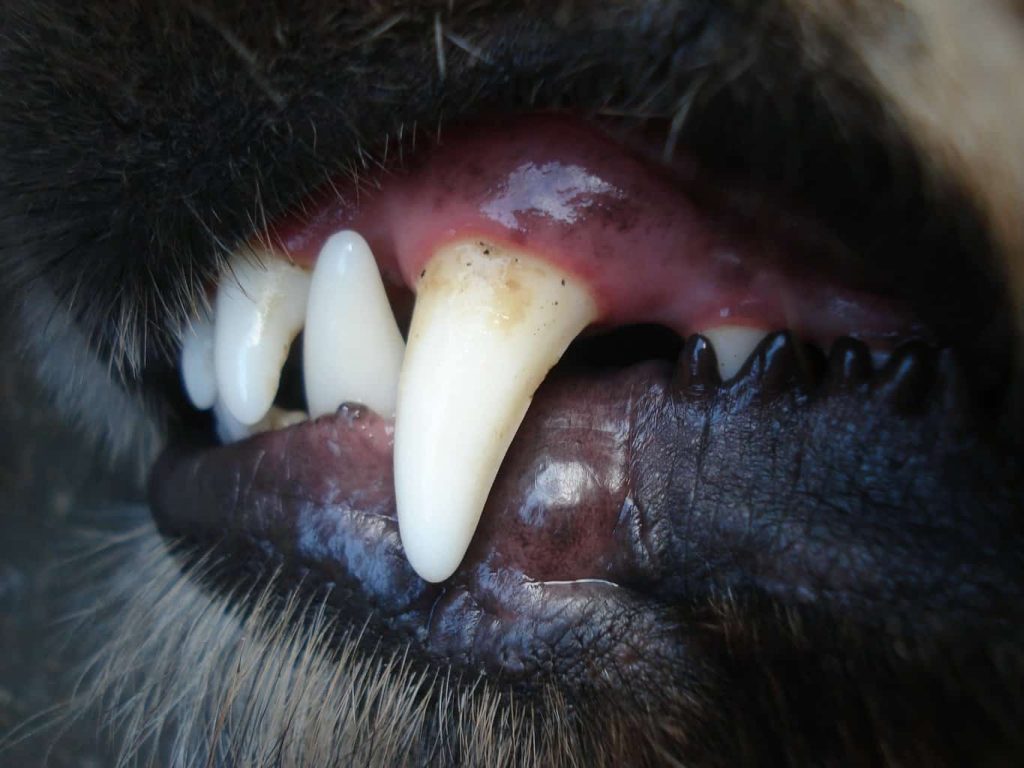
2. Whoodle Dental Care
Dental care is important for all dogs, this includes the Whoodle. Dental disease is a precursor to many other diseases. So, a little prevention goes a long way.
Daily toothbrushing is a great way to prevent dental disease. Starting out with tooth brushing at a young age is a great idea. Be sure to use a doggie toothpaste that is safe to swallow.
Chewing is important for dogs throughout their lifetime, not just when they are teething. Chewing is also an important aspect of dental care. Chewing is wonderful for a dog’s mental well-being. If you choose the right chews they can also provide mental and physical stimulation, which helps the Whoodle to burn a little more energy.
Good chewing options include stuffing your dog’s food into a Kong or other hollow toy. Other wonderful options include dehydrated trachea, bully sticks, lamb ears, pig ears, and raw bones. Raw bones are a wonderful option for chewing and offer great nutritional benefits as well.
3. Whoodle Nail Trimming
It is important to keep your dog’s nails short. Long nails can be painful and can exacerbate arthritis and other joint issues. Long nails can even cause back issues in smaller dog breeds.
Check and trim your Whoodles nails on a monthly basis. Some particularly active dogs may not need their nails trimmed that often, but it is still a good idea to check the nails on a weekly basis. It also makes the experience less of a hassle if your dog is more used to it.
Get your Whoodle pup used to nail trimming at a young age. Be sure to offer plenty of treats to make nail trimming a fun, and not scary, time. Also, try to avoid cutting the quick. This can be very painful and make the dog not want his nails trimmed anymore!
4. Whoodle Ear Cleaning
The Whoodle can sometimes experience wax build up in the ear. If you notice that your Whoodle has excess wax you may want to clean the ears with a simple solution of half apple cider vinegar and half filtered water.
Dip a cotton ball in the solution and use it to wipe the ear. You can also drip the solution into the ear and massage the ear to work the solution deeper into the ear.
What Health Problems Can Whoodles Have?
The Whoodle can inherit the health issues of either parent dog breed. Poodle and Wheaten Terriers can suffer from a range of different health problems, and some of these can be passed to the Whoodle puppy.
The Whoodle can suffer from many health issues as they age. Possible health conditions can include hip dysplasia, multiple eye issues, bloat, sebaceous adenitis, von Willebrand’s disease, luxating patella, Legg-Calve-Perthes, epilepsy, and some immune-mediated disorders, protein-losing nephropathy, protein-losing enteropathy, renal dysplasia, and Addison’s disease.
If you are thinking of getting a Whoodle then you should seek a reputable breeder that can answer any health related concerns that you may have. It’s also a wise idea to look into these health concerns yourself and learn what they are and how you can prevent them.
What’s The Best Food For Whoodles?
The Whoodle is a high energy mixed breed dog, and if given enough exercise, is unlikely to become obese. However, any dog may gain too much weight. You are ultimately responsible for your dog’s weight. You control how much exercise he gets and how much food he has access to.
The Whoodle will thrive on a diet that is high in animal protein and has little to no carbohydrates in it. This is because even the adorable Whoodle is a carnivore and carnivores are made to eat meat. Keep this in mind as you look for appropriate food for your dog.
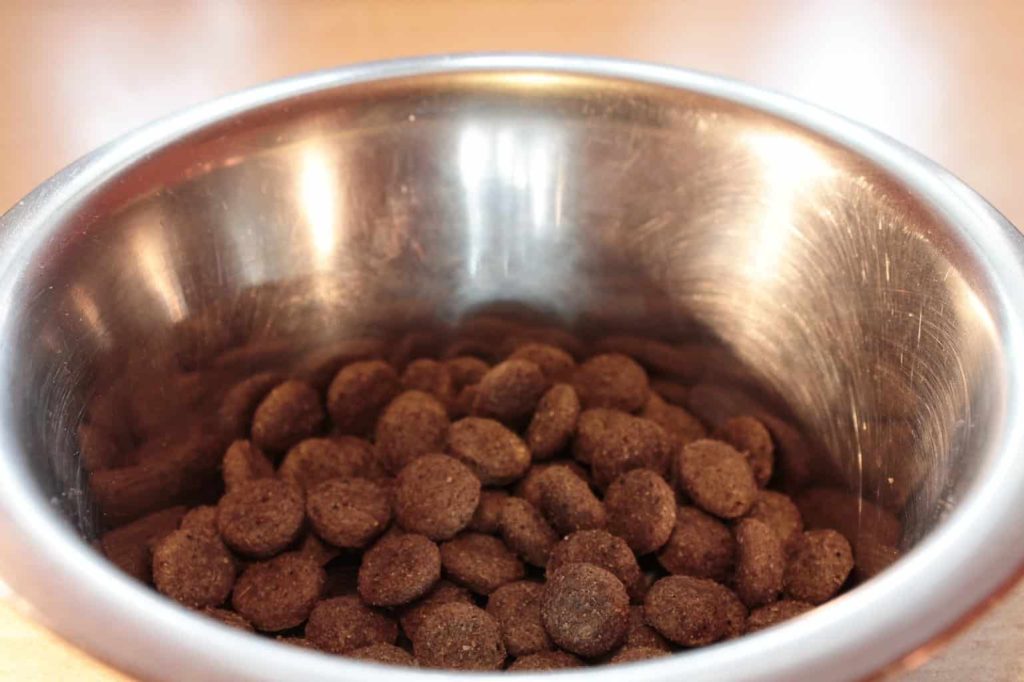
You can choose from kibbles, canned, freeze-dried, dehydrated, lightly cooked, and raw diets for your Whoodle. The main concept to keep in mind is that you want a diet that is low in carbs and high in animal protein. You will need to read the ingredients and nutritional labels to get a proper view of what the food is made of. You will want to do this because what you feed your dog can either act as preventative medicine or poison.
What type of treats are good for Whoodles?
You will want to hold your Whoodles treats to the same standard of low in carbohydrates and high in animal protein. This will help to ensure an all-around healthy diet giving your dog treats you can be proud to feed him vs. treats being little “cheats.” Good options include dehydrated or freeze-dried meat. These treats often have no carbs at all and are of high-value to the dog.
Whoodle dental care
As stated before chews are great for dental care. Chews should also be held to the standard of high animal protein and low in carbohydrates. Options could be raw bones, dehydrated lamb ear, dehydrated trachea, or freeze-dried rabbit ears, to name a few.
How Much Does A Whoodle Cost?
The Whoodle is a fairly rare designer dog breed. The rarity of the breed makes Whoodle puppies one of the more expensive dog breeds. To buy a Whoodle puppy from a breeder you can expect to pay anywhere from $1,500-$5,000. Rare colors will be more expensive. You can also rescue a Whoodle and likely save considerably on costs – something we suggest all responsible pet owners consider doing.
Where To Get A Whoodle
If you want to add a Whoodle to your family try to find a reputable Whoodle breeder. A reputable breeder will breed for the health and temperament of the puppies. They should also have a rigorous socialization program in place to ensure that the Whoodle puppies get along with other dogs and of course, the new pet owners.
Do not assume that any breeder is a good breeder. There are lots of dog breeders out there that are only in it for the money and do not care about the puppies’ health. Keep this in mind as you look for a breeder. If you get a weird feeling or feel that you can’t trust the breeder, find a different breeder.
Adopting a Whoodle
You can, of course, find some Whoodles in shelters and from rescue groups. You may have to contact purebred rescue groups. The Poodle Club of America and Wheatens In Need are two such options. These groups will often rescue mixes of their breed as well.
If you are considering rescuing a Whoodle remember that the dog was surrendered for a reason. Perhaps he was too hard for his owner to train, he didn’t get along with the kids, he ate the family hamster, his owners couldn’t afford his health problems, or something else. This is not to say that you should not get a rescue Whoodle. Just be extra careful when considering this option.
If you have time, money, and patience to use to help a rescue Whoodle. Then go look for one! They deserve forever homes too.
Whoodle Breed Roundup
A Whoodle is a mixed breed dog that comes from a Poodle and a Soft-Coated Wheaten Terrier. The Poodle may be a toy, miniature, or standard Poodle.
Whoodle size
The Whoodle is a medium-large breed dog. He is playful, loyal, and active. He has a dense, single coat that can be either curly or wavy.
Whoodles in apartments
Most Whoodles do well in apartments as long as they get the exercise they need. The breed does enjoy a fenced yard to run in if you have that.
Whoodles and children
Whoodles do well with children and other dogs. However, they may try to hunt and chase smaller pets. The Whoodle is hypoallergenic and may be a good option for persons with allergies.
Training a Whoodle
Training the Whoodle can be challenging if he takes after the Soft-Coated Wheaten Terrier side. However, the breed is very intelligent and if you find the right motivation he will be a willing student. The Whoodle is high-energy and needs, at an absolute minimum, 1 hour of exercise a day. However, the Whoodle will accept as much exercise as you can give him.
Grooming a Whoodle
Grooming the Whoodle is not overly complex. He will need daily brushing and a visit to the groomer every other month for a trim. Consistency in brushing, toothbrushing, and nail trimming are essential for good overall health.
Whoodle health issues
Whoodles can get any of the health issues that Poodles and the Soft-Coated Wheaten Terriers can get. It is a good idea to read up on how to prevent these health issues. That way you can implement what you learn and create a prevention plan for your Whoodle.
What to feed Whoodles
The Whoodles diet should consist of food, treats, and chews that have little to no carbs and are high in animal protein. This is good preventative medicine and will help to ensure your dog lives a long and healthy life.
Whoodles are a relatively new breed and finding one can be tricky. There are, however, some good Whoodle breeders out there or you may also be able to find a Whoodle to rescue. If you choose to bring a Whoodle into your life be ready for loyalty, fun, and lots of energy!
Sources
http://www.poodleclubofamericarescuefoundationinc.org/about-poodle-rescue.html
https://www.wheatensinneed.org/adopt

